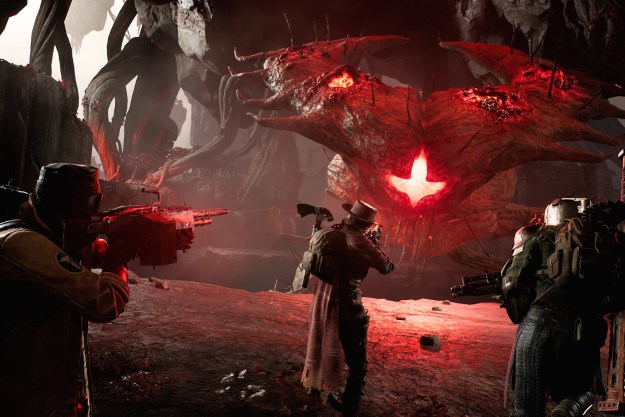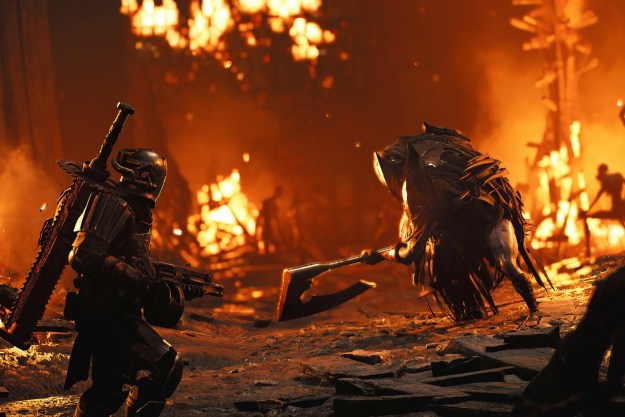 I have to admit, I wasn’t sure what to expect from Sega and Yakuza Studios’ Binary Domain. I had seen the game in various stages of development, and it looked alright but was fairly unremarkable in the bits and pieces that were displayed. Even the name felt slightly uninspired, and the generic cover art of “hero guy” shooting at something while screaming wasn’t going to make it to poster size to adorn too many walls. Throw in Sega’s recent track record of publishing me-tacular, and color me skeptical.
I have to admit, I wasn’t sure what to expect from Sega and Yakuza Studios’ Binary Domain. I had seen the game in various stages of development, and it looked alright but was fairly unremarkable in the bits and pieces that were displayed. Even the name felt slightly uninspired, and the generic cover art of “hero guy” shooting at something while screaming wasn’t going to make it to poster size to adorn too many walls. Throw in Sega’s recent track record of publishing me-tacular, and color me skeptical.
I am glad to say that I was proven wrong, for the most part. Binary Domain is a game that is better than it has any right to be judging by the promo art. There are still some major flaws both in the design and the technical side of things, but the overall presentation is actually very, very good. The look of a futuristic and isolated Tokyo is impressive and sometimes even jaw-dropping, and the robotic enemies are better than you might first suspect. That doesn’t excuse the failings of Binary Domain, but it does justify the time you will spend playing it.
In the future, no one can hear you reboot
Binary Domain takes place in 2080, years after environmentalists worldwide have wept bitter tears following the melting of the polar ice caps. What followed was pandemonium. The oceans rose, cities floods, dogs and cats were living together. End of the world stuff. But once the waters subsided, the rebuilding began. The population was nowhere near what it was, so many nations turned to robotic labor to help take the jobs that humans couldn’t. That bred a new robotic culture around the world.

You step into the shoes of American ex-Special Forces soldier Dan Marshall, who is now part of an international crew known as a Rust Team. After a gutsy infiltration into the city, you then begin to meet up with your squad—although it will be much later into the game before you have a full complement of international soldiers.
You might think that a game where you shoot robots for hours would skimp on the story but (with a few exceptions), Binary Domain is actually fairly deep. The cut scenes can be entertaining, and a few of them border on thought-provoking. When a hollow child realizes that it isn’t human, it is actually a horrific moment of realization, and the reactions to it can be extreme—and very human.
The city of Tokyo is also greatly changed, and there is an underclass that literally lives under the upper class, which can lead to some surprisingly fleshed out supporting characters that may only appear for a few moments, but make an impression.
The design of the city is impressive, and becomes a character of its own. You will occasionally be relegated to the traditional hallway and warehouse that so many action games rely on, but that is the minority. The city is an incredible site: massive and unforgiving, yet beautiful and lush.
There are a few issues in the story, including the stereotypical American black man that teeters between annoying and vaguely offensive, and there are a few moments that are laughably bad, but overall, Binary Domain paints an incredible picture of the future, that draws heavily on dystopian visions. If you are a fan of Blade Runner, you’ll feel right at home in the Tokyo of tomorrow.
Attack of the drones
It is easy to dismiss the gameplay of Binary Domain as a Gears of War clone. That’s because it is.
Actually it is identical to most third-person shooters that use cover, but it really draws heavily on Gears as an influence. That isn’t a bad thing though as the Gears-style of third-person action is a legitimate counter to the over saturation of first-person shooters on the market. If there can be fifty FPS titles that use similar, if not identical, gameplay mechanics, there is no reason Binary Domain can’t use the same style as Gears.

Putting that aside though, the combat is actually very satisfying. Like Gears, you can carry two primary weapons, a pistol, and grenades. The variety is weak, but each character has their own unique primary weapon, which can be upgraded with points earned thanks to an arcade-like scoring system that awards points for everything from beating bosses to headshots.
The idea of fighting nothing but robots at first may feel a bit sterile, or “hollow,” to borrow the game’s vernacular, but it is anything but. The enemies in Binary Domain are what make the game worth playing. The robotic soldiers are dogged and relentless, and simply shooting them a few times won’t do it. There will be times when you have to retreat, as the onslaught can be endless.
If you shoot a weapon wielding arm off a robot, it will pick up its gun and continue to fire. If you shoot its legs, it will crawl towards you. If you take off its head but leave the body intact, it will then blind fire, sometimes hitting other enemies until they put it down. Each shot can mean something, as robot armor will fly off, or limbs will break, which is actually kinda awesome. The enemy will also flank and try to get the best angle. The harder difficulty settings and the later levels on normal setting will require you to hone your headshot abilities, or you will quickly find yourself in trouble throughout the 10-ish hours of the campaign.
The enemy variety is ever changing as well, and while the humanoid robot is the most common, it is far from the only one. Metal spiders that turn into explosive spheres haunt the sewers, drones occupy the air, automated defensive automobiles inhabit the highways. The enemy variety is well done.

The game also does a great job of mixing in some variety, including a tense chase through a tunnel, a mech-like attack, and dodging falling debris, just to name a few. Every time you think you have seen all the game has to offer, it throws something completely new at you.
The charge of the red shirts
Speaking of your teammates, each team member is a specialist in a particular field: the Chinese representative Faye is a sniper, the Brit Rachel is a demolitions expert, etc. etc. As you start each new section, you are given the choice of which two teammates you want covering your six.
There is also an intriguing trust system with each character that affects their actions. You can build up trust by playing well or answering their questions in ways they want to hear, or you can lose it by ignoring them or getting them hurt.

That’s actually a good thing too, because the ally AI seem hell bent on tricking you into killing them. You can be stationary in cover, minding your own business while attacking enemies, and suddenly your teammate will run in front of you and get themselves shot, which loses their trust. It is annoying, but doesn’t hurt that much.
Testing, one, two, testing…
A major feature of Binary Domain is the ability to issue voice commands to your teammates, and verbally respond to their questions and requests. It sounds like a great idea, and there is even a vocal calibration tool that will help you to fine-tune things like background noise and record your commands into memory to make it clear what you are saying, but unfortunately it almost never works properly. On the plus side, it can lead to some hilarious moments.
While braving the sewers with Bo and the British covert specialist Charlie, I tried repeatedly to get either of them to advance, but the mic did not recognize the command. After the fight, without me saying a word, the background sounds of water rushing through pipes was apparently interpreted as “Charlie, I love you.” It led to an awkward conversation.
You’ll be lucky to have a 50-percent success rate. It was a good idea now, just like it was a good idea when SOCOM: U.S. Navy SEALs tried it on the PS2. It didn’t work then either.
Thankfully you can just use the controller commands. They lack the finesse of the verbal commands, but they’ll get the job done.
Post-construction multiplayer
Binary Domain offers both a competitive and a co-operative multiplayer, and both feel like they are modeled off the Gears of War MP. There is both a competitive mode which features all the modes you would expect, as well as a four player co-op horde-like mode called “Invasion.” Both are a fun diversion, but neither really offer anything new or fresh.

It would have made more sense to make the entire game co-op friendly. You are almost always with two AI teammates—not having that option doesn’t hurt the game, but replacing them with humans would have taken this game to the next level.
Conclusion
Despite a few issues that mar Binary Domain. The multiplayer is forgettable, but the campaign has a lot to offer–it just lacks a bit of polish. The story is compelling, the character interaction is deeper than you might first think, and Tokyo of tomorrow is beautiful and well thought out. There is even a scene when the crew runs through a massive spherical garden, tended by robotic gardeners producing enough vegetation to feed a city. And that is just filler between combat zones. The game is packed with incredible moments like that.
Binary Domain is a surprisingly smart, beautifully designed game that features interesting gameplay. The developer behind the game, Yakuza Studios, is relatively new (despite being filled with many longtime Sega alum, including the producer of the Yakuza series, Toshihiro Nagoshi). If it can build on what it started with Binary Domain, Yakuza Studios may be a developer to watch in the future.
Score 8 out of 10
(This game was reviewed on the PlayStation 3 on a copy provided by Sega)
Editors' Recommendations
- How to beat Bile Spewers in Helldivers 2
- The best weapons in Helldivers 2
- Alone in the Dark: release date, trailers, gameplay, and more
- How to unlock the The Archon in Remnant 2
- How to unlock the Alchemist in Remnant 2


